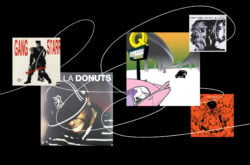Whether it’s ancient reel-to-reel or dusty cassette multitrack recorders, you’d be hard-pressed to find someone who loved the shortcomings of the technology behind tape machines in their heyday.
And yet, decades later, it’s mostly the quirks and faults of the gear that have been incorporated into the modern workflow. While some drawbacks were actively avoided (wow, flutter, noise), some limitations inspired creative results (delay, flanging). We’ve come a long way in the digital age, but the desire for what was considered the weakness of tape has proved too powerful to resist. In this article, let’s explore the main ingredients of the lo-fi magic of tape machines.
Saturation: Magnetic charm
Tape machines are uniquely equipped to provide a pleasing harmonic distortion when pushed hard. Without getting too deep into specifics, the recording side of the tape is coated with magnetic particles. If you raise the input signal far enough, the magnetic particles become misaligned, leading to saturation. A time-tested technique is pushing drums to the saturation point on tape, which also creates a natural-sounding compression.
In the first example below, you’ll hear XLN Audio’s Addictive Drums run through T-RackS’ Tascam Porta ONE. This series of multitrack tape recorders was the very first on the market, starting with the TEAC 144 in 1979. All I did was push the input to drive the signal and add a touch of tape bias (explained below) while compensating with the output. Take a few listens and pick out one drum piece each time, and compare how they sound before and after.

Before:
After:
In the second example below, I’m driving a guitar beyond overdrive and into the realm of distortion using input and bias. When recording to tape, there isn’t a 1:1 relationship between the input level and the output from recording. This means that low levels might not be picked up at all, but as the signal gets louder, the recording level gets exponentially louder—this is what’s called non-linear. Instead of a straight line, the relationship between the input signal and what’s recorded is a curve.
To adjust for this, tapes would add bias, which is an inaudible high-frequency signal added to the tape to make it think lower signals are louder. This could create a more linear relationship, but if you push the bias even further, you get a non-linear result in the other direction; quiet sounds become much louder, and eventually distort. But, tape distortion doesn’t have the nasty edge you might find in digital distortion, so it’s perfect for a rounded, high-gain guitar sound. I also added a tiny bit of tape delay from T-RackS’ Space Delay.

Before:
After:
Wow and flutter: Bad gear turns good
Surprisingly, one of the most charming aspects of tape is its instability. What was considered a side effect of the technology is now regarded as a feature. Wow is a slower, more consistent variance in speed which changes the pitch of the sound. Meanwhile, flutter describes sudden, more obvious jumps in speed (and therefore pitch) at random intervals. Think of wow as waves and flutter as noise. Both of these came from faulty hardware that kept the tape from rolling smoothly.
I created a basic pad using the stock plugin Drift in Ableton Live. The real magic comes when adding Baby Audio’s TAIP. I added a bit of presence and turned the wear all the way up, which emulates the wow of a dysfunctional tape machine. This might seem extreme in a lot of cases, but TAIP knows that a little goes a long way and keeps the wobble subtle, even at the highest setting. Listen to the tail end of the pad to hear the pitch movement.

Before:
After:
For flutter, I used Arturia’s Tape MELLO-FI with the FLUTTER setting just past halfway on another custom patch made with Drift. These rapid fluctuations add an eerie but soulful vibe to the solo. To give it more atmosphere, I used the reverb unit solo on Arturia’s Delay TAPE-201.

Before:
After:
Speaking of delay…
Tape Delay: Hardly a copy
No analog tape machines can record and play a sound simultaneously. There’s always a delay between where the recording head records the sound and the playhead that plays it back, because they’re physically spaced apart. If you were to listen to the recording source as well as the playback at the same time, you would hear the source twice.
This is how musicians and engineers discovered tape delay—by recording the source separately from the tape, and also recording the delayed version from the tape. Beyond that, if you took the delayed signal from the tape and found a way to feed it back into the tape machine, you’d hear the echo repeat. Each repeat would lose fidelity, morphing into a completely different version of itself by the time the sound disappeared.
Eventually, units were developed to utilize tape exclusively for delay, with more control over delay time (achieved by the speed of the tape and the space between the heads) and feedback (how much delay is fed into itself). The most iconic of these machines is the Roland RE-201. Listen to this guitar slide run through Arturia’s emulation of this plugin with feedback and delay time automated:

Before:
After:
Now imagine having the duplicated signal come in almost immediately after the source and removing the feedback, so that the signal never repeats but just keeps playing. This is called tape flange. Doing this with hardware tape machines requires a ton of setup and synchronization, but luckily for us, software makes it very easy.
In the example below, I’ve added Softube Tape to guitar chords, turned the mix knob halfway to blend an equal amount of dry and processed signal, and turned the SPEED STABILITY knob to above 50%. The wobble this adds to the tape puts the affected signal out of phase with the original at various times, resulting in the classic, woosh-y flanger sound.

Before:
After:
Filtering: Sometimes, less is more
A lot of tape machines simply can’t replicate the full spectrum of sound the way modern digital tools can. Part of the charm is the way some tape machines (especially cheap ones like dictaphones) restrict the bandwidth. The Mellotron is a great example of this. This machine consists of pieces of tape with a single instrument note recorded to them. This might not seem like a big feat, until you realize there’s a tape recording for every key (52 on the M300)!
The resulting loss of fidelity seemed to do nothing to stop the Mellotron from being a huge part of the sound of the ’60s (think “Strawberry Fields Forever”). Through it, vibrant, bright flutes become warm and mid-range, and violins lose all trace of resonance—but the results are magical:
Noise: The lo-fi blanket of tape machines
When using analog tape machines, you simply can’t get away from noise. Engineers spent hours and came up with various techniques to combat tape noise, only to be greeted by its intentional injection in the name of nostalgia decades later.
Thankfully, nearly every plugin allows you to adjust the noise level of the tape emulation. To help a track sound like it exists in a cohesive space, a mastering engineer might add a very subtle ambiance using a light, natural-sounding reverb. Noise works the same way, by creating a consistent environment in which the track lives.
When it comes to tape, noise is just as an essential part of the experience, as is all of the above.
The lo-fi magic of tape machines: The results
Below, you can hear the results of the complete track with and without processing to hear the stark difference. The only effects used are tape emulations and some light EQ.
Before processing:
After processing (with TAIP also on the master):
Download the project file for free
If you’d like to experiment with the Ableton Live project file for this track yourself, you can download it with all of the stems for absolutely free here. Most of the plugins that we highlighted in this article can also be tried for free via Splice Rent-to-Own.
Do you have any questions about the technology behind tape machines? How do you use its qualities in your productions? Start a conversation with us and a vibrant community of other music creators via the Splice Discord.
Try IK Multimedia’s T-RackS for free, and then Rent-to-Own the plugin for $14.99/mo until you own it outright:
September 8, 2023



